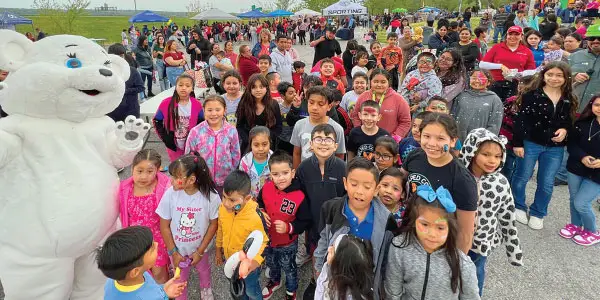
Encontraron el cadáver del niño Gilberto Ramos con un rosario blanco. Era el que le había dado su mamá al salir de San José de Las Flores, una población pobre y montañosa al norte de Guatemala. Murió de hambre y sed en el desierto de Texas, a una milla de la frontera con Mé xico. Tenía sólo 15 años.
xico. Tenía sólo 15 años.
Gilberto estaba cansado de ser pobre y de no tener dinero para las medicinas que necesita su mamá, Cipriana Juárez, para controlar sus ataques epilépticos. La familia juntó casi tres mil dólares para pagarle al “coyote” y así Gilberto llegó a la ciudad fronteriza de Reynosa, México. Desde ahí, del lado mexicano, hizo su última llamada a su papá, antes de cruzar ilegalmente hacia Estados Unidos.
Su cuerpo estaba sin camisa —quienes sufren deshidratación suelen quitarse la ropa antes de morir— y en su cinturón encontraron escrito un número de teléfono. Era de su hermano Esbin, quien hace dos años hizo el mismo trayecto y hoy trabaja en Chicago.
“Estaba esperando la llamada de él”, me dijo Esbin en una entrevista. Pero “nunca pasó eso”. Quien le llamó, en cambio, fue una representante de la Patrulla Fronteriza en Texas avisándole que habían encontrado el cuerpo de su hermano Gilberto.
“Yo le dije que estaba muy pequeño, que mejor se quedara otro rato más allá” en Guatemala, recordó Esbin, “y él me dijo que no, que no quería estar allá, estaba desesperado”.
La pobreza extrema lleva a muchos, como Gilberto y Esbin, a intentar emigrar a Estados Unidos. Otros lo hacen por la violencia de las pandillas, como los hijos de la hondureña María (quien prefiere no dar su apellido por motivos de seguridad).
María, quien vive en Miami, me enseñó el mensaje de texto que recibió de la Mara 18 de Tegucigalpa. “Te doy hasta mañana para que tengas mil dólares en tus manos y si no tu hijo o hija morirá”, decía el texto que aún guarda en su celular.
En lugar de darle el dinero a los pandilleros, María le pagó siete mil dólares a un “coyote” para que llevara a su hijo Eduardo desde Tegucigalpa hasta Estados Unidos. “Mi hijo pasó la frontera como un menor no acompañado”, me dijo con lágrimas en los ojos. “Lo llevaron a Illinois. Me lo entregaron en dos semanas pero él está traumatizado. Aún no quiere ir al colegio”. Pero ella cree que le salvó la vida.
Las amenazas de la pandilla contra esta familia, sin embargo, no se detuvieron. Zaira, la hija de María, recibió meses después el siguiente mensaje: “O depositas o vas a encontrar a tu hija, Yaritza, en una bolsa de basura”.
María, sabedora de lo que estaba pasando en Honduras, juntó nueve mil dólares y mandó traer ilegalmente a su hija Zaira y a sus nietos Yaritza, de 8 años, y Naum, de 4 años. Los tres cruzaron caminando la frontera de Estados Unidos y se entregaron a las autoridades. No fueron deportados y ya se encuentran viviendo en Miami.
María ha podido salvar a un hijo y a una hija de las amenazas de las pandillas. Pero aún le quedan tres hijos en Honduras. Y, si puede, se los va a traer también. Imposible culparla.
Estas dos historias, una de Guatemala y otra de Honduras, demuestran claramente por qué más de 52 mil niños han huido de Centroamérica y se están refugiando en Estados Unidos. Huyen de la pobreza y la violencia. Si se quedan allá, se mueren. Por eso hay que tratarlos como refugiados.
Hay que tratar a estos niños, como si fueran nuestros hijos. Y uno no deporta a sus propios hijos ni los quiere tener en otro país.
Entiendo el dilema del gobierno de Barack Obama. No quiere enviar un mensaje equivocado y que le lleguen decenas de miles de niños más a la frontera. Pero no podemos tratar a niños como delincuentes.
Sí, el trayecto desde Guatemala, El Salvador y Honduras hacia Estados Unidos es peligrosísimo. Ya ven lo que le pasó a Gilberto en el desierto. Pero hay que cuidar a los que ya llegaron. Regresar a Eduardo y a Zaira a Tegucigalpa podría ser una sentencia de muerte.
Con los niños en la frontera, la primera orden es no hacer más daño. Ya luego veremos qué sigue.
A death in the desert
Before Gilberto Ramos left San Jose de las Flores, an impoverished Guatemalan mountain village, for the United States, his mother gave him a white rosary.
Weeks later, after a long, treacherous journey, his body was found in the Texas desert.
He had likely succumbed to dehydration about a mile north of the Mexican border. He was only 15 years old. He was found clutching the rosary his mother had given him.
Months before he left, Gilberto Ramos had become exasperated by his family’s extreme poverty and the fact that they couldn’t afford medicine to treat his mother’s epileptic seizures. He decided to head north to seek a better life and try to send back some money.
His family collected almost $3,000 to pay a smuggler – or “coyote” – to help him get to the United States. When he made it to Reynosa, Mexico, he called his father one last time before he crossed the border illegally.
In Chicago, his brother Esbin was waiting for him to call. Instead, Esbin got a call from authorities who had found his phone number written on the inside of his brother’s belt.
Esbin Ramos, who had made the same journey from Guatemala in 2012 and lives and works in Chicago, said he had tried to dissuade his brother from coming to the United States. But Gilberto was determined.
“I told him that he was too young and that he should stay there for a while longer,” Esbin told me. “But he said no, that he didn’t want to be there. He was desperate.”
Extreme poverty leads people such as Gilberto and Esbin Ramos to head to the United States because they feel they have no other way to survive. Meanwhile, other Central Americans come here to escape the constant threat of gang violence.
Recently, I spoke with Maria, a woman from Honduras who has lived in Miami for a few years. In 2013, she received a text message from a member of “La Mara 18,” a street gang. “You have until tomorrow to collect $1,000. If not, your son or daughter will die,” the message read. “You’ll receive more instructions tomorrow, Maria.”
She still has the message saved on her phone.
Maria said she gave the gang $500 – all the money she had – to buy some time. Over the course of a few months, she collected about $7,000 and paid a coyote to take her young son Eduardo, who was still in Honduras, to the border.
“My son crossed the border as an unaccompanied minor,” she told me.
The Border Patrol then took her son to a processing center in Illinois. “They handed him over to me two weeks later, but he’s still traumatized,” she said.
She’s convinced she saved his life.
A few months later, Zaira, Maria’s daughter, received a message from the same gang. If she didn’t give them money, “you’ll find your daughter, Yaritza, in a trash bag,” the message said.
Maria raised another $9,000 to pay a coyote to bring Zaira and Zaira’s children, Yaritza, 8; and Naum, 4; to the United States. The three of them crossed the border on foot and turned themselves in to the American authorities. They’re living in Miami.
Maria has three other children still in Honduras. If she can, she’ll bring them here, too. Who can blame her?
These two anecdotes – one from Guatemala, one from Honduras – clearly demonstrate why more than 52,000 unaccompanied children have fled Central America to seek safety in the United States. They’re refugees. We must treat them as such. We must treat them as if they were our own children.
That said, I understand the dilemma the Obama administration faces. President Obama doesn’t want to send the wrong message and spark an exodus of thousands more children toward the border. But we can’t treat these kids like criminals.
The journey from countries such as Guatemala, El Salvador and Honduras to the United States is fraught with danger, but sending them back could prove more perilous. For some, returning home would mean death.
When it comes to this border crisis, first things first: Let’s resolve to protect these children from further harm. Then, we can decide what comes next.









